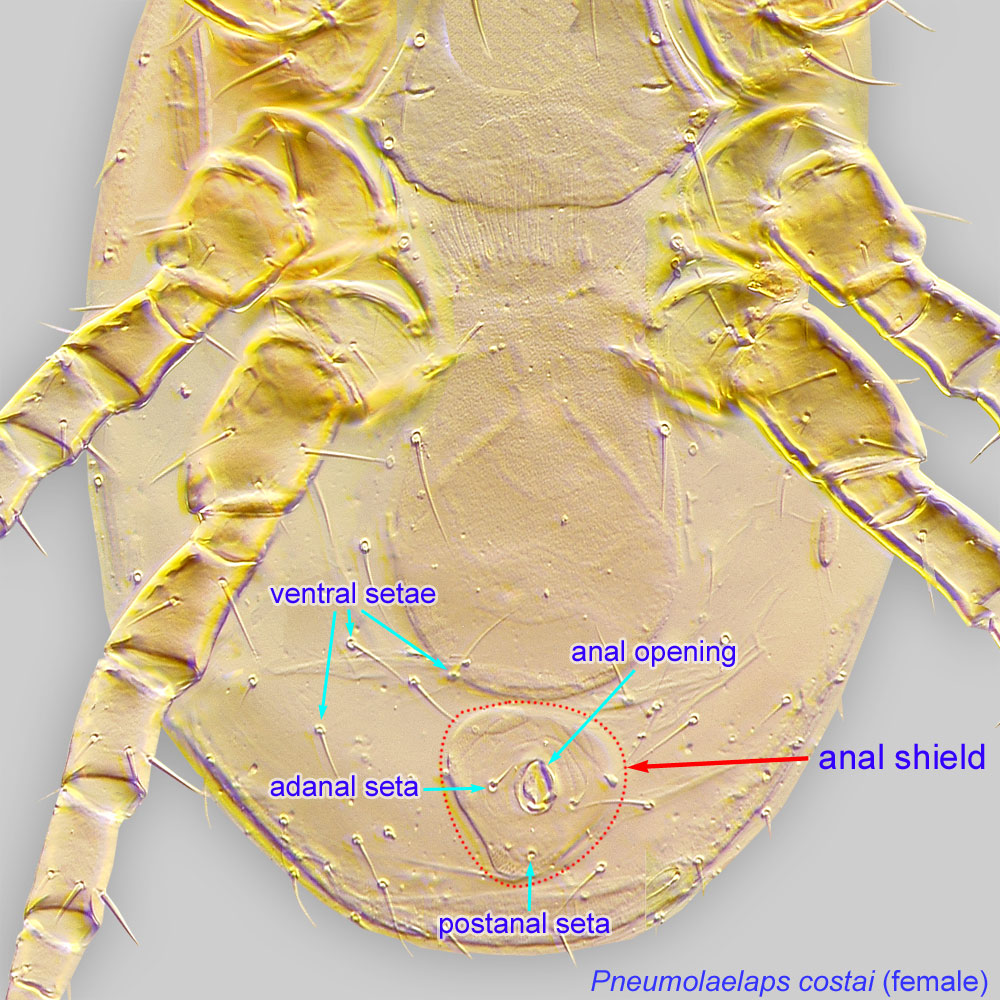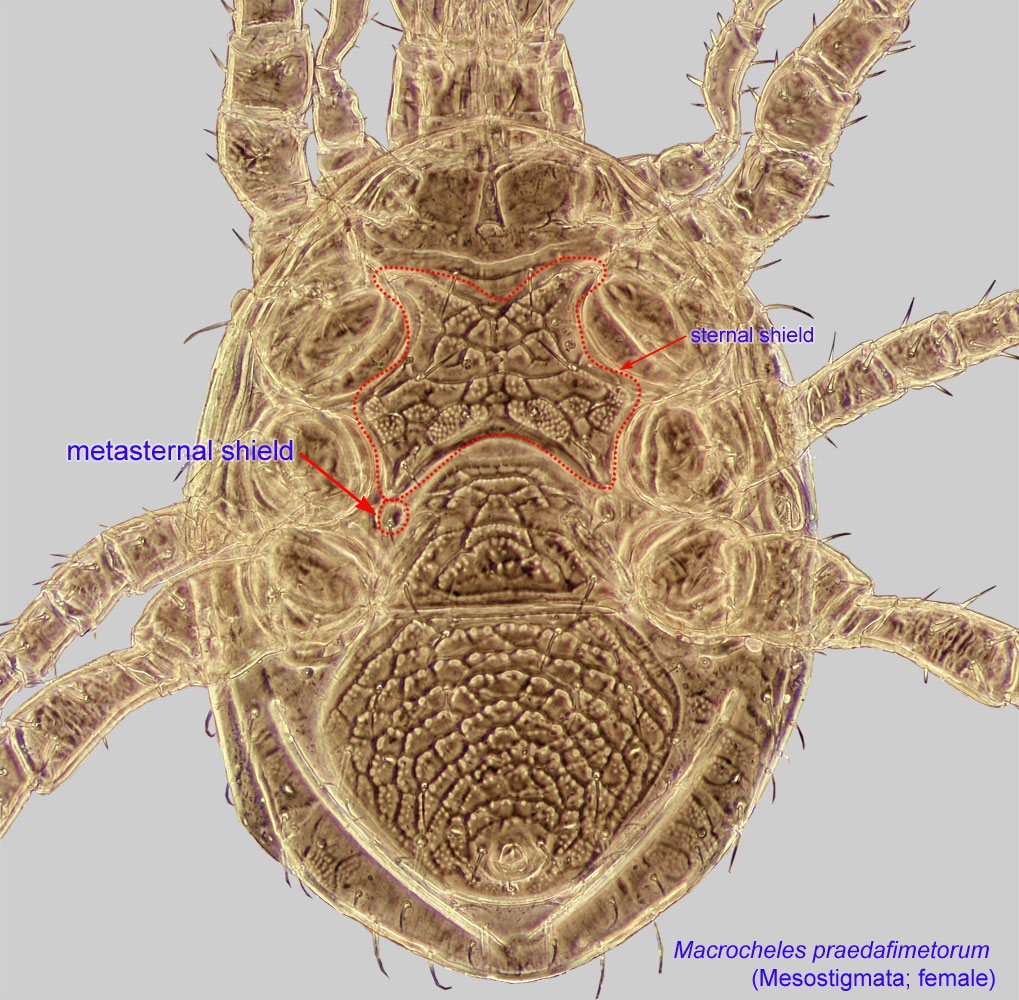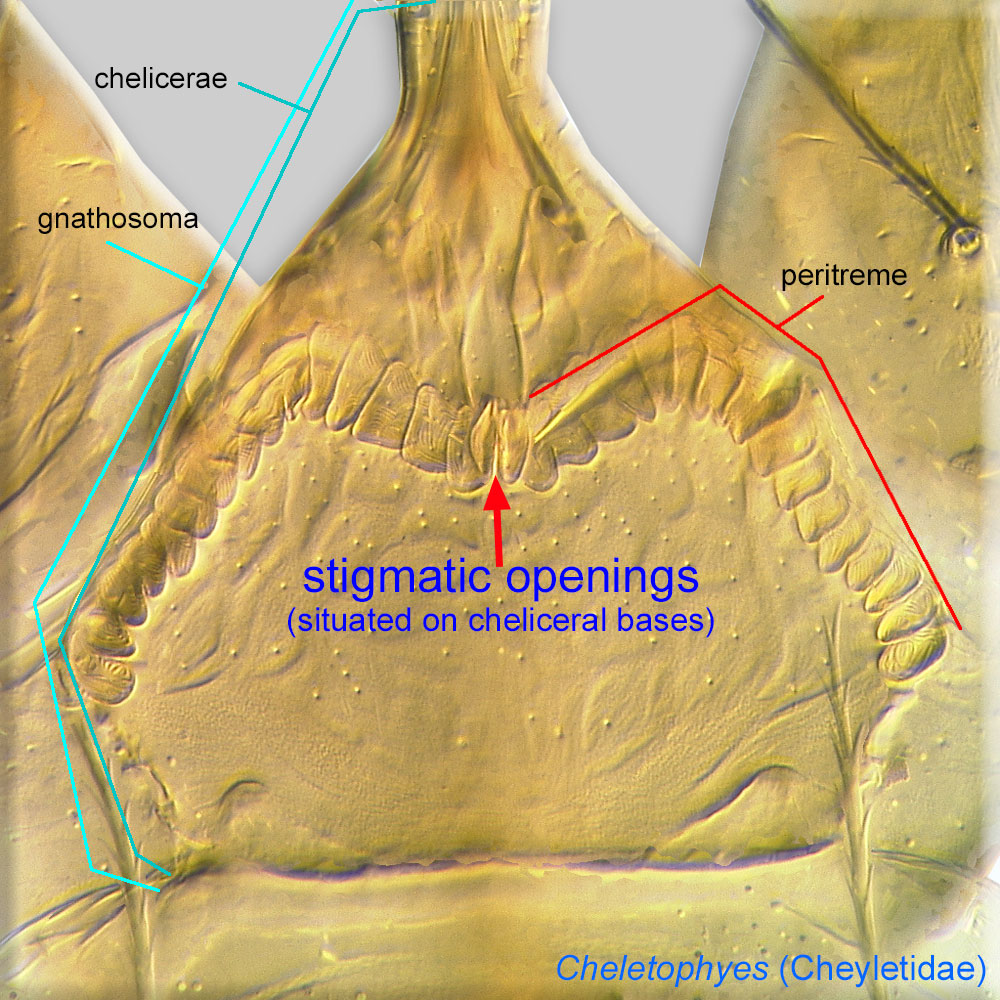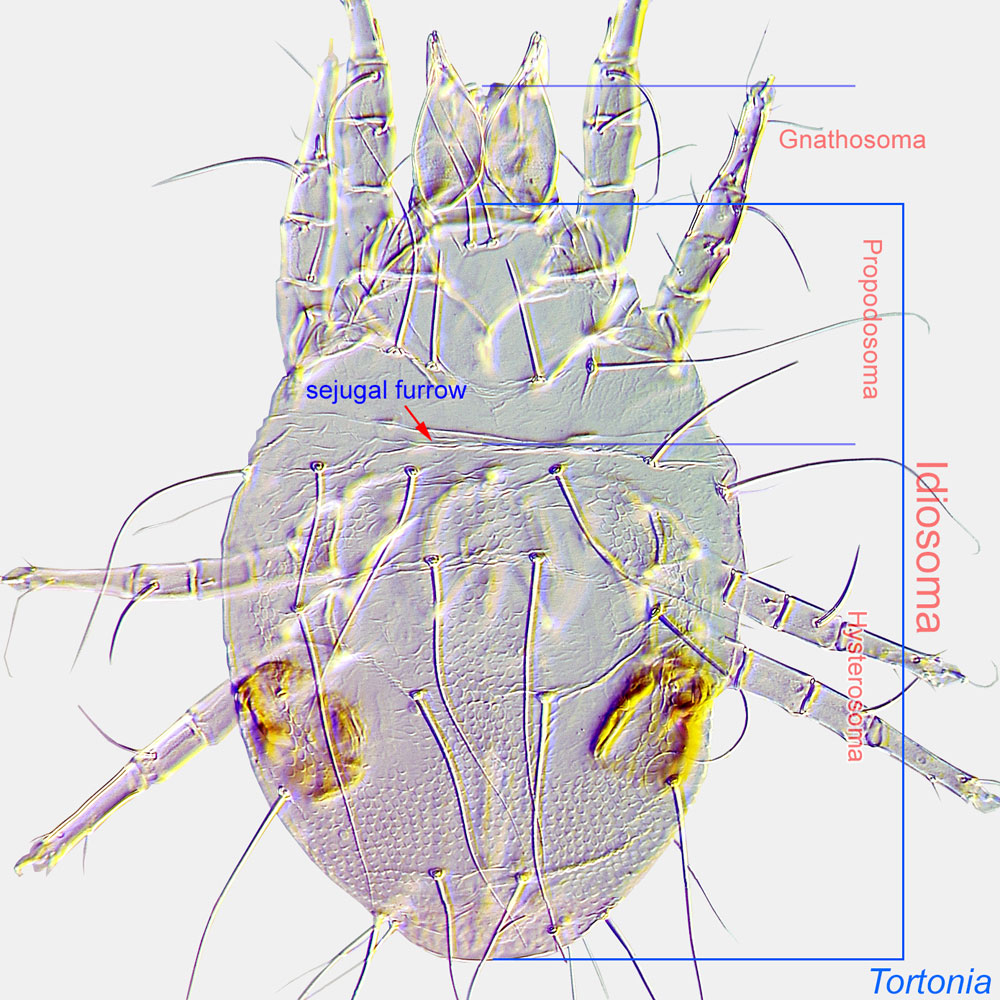neutral; feeds on spillover or discarded pollen in hive floorboards
Melittiphis Berlese, 1918
Superorder Parasitiformes » Order Mesostigmata » Suborder Monogynaspida » Hyporder Dermanyssiae » Family Laelapidae » Genus Melittiphis
Laelaps (Iphis) alvearius Berlese, 1895
Melittiphis is commonly misspelled as "Mellitiphis."
pollen mite
Female and Male. Presternal region in the female with a keel-like ridge (Figs. 2, 3). Anal shieldanal shield:
In Mesostigmata, a ventral shield bearing the anal opening and circumanal setae (adanal or postanal setae), but without any ventral setae or pores (lyrifissures) on it. If ventral setae are present on shield than referred to as a ventrianal shield.
 of female and ventro-anal shield of male with a posteriorly directed spur anterior to the anus (Figs. 2, 5). Anal shieldanal shield:
of female and ventro-anal shield of male with a posteriorly directed spur anterior to the anus (Figs. 2, 5). Anal shieldanal shield:
In Mesostigmata, a ventral shield bearing the anal opening and circumanal setae (adanal or postanal setae), but without any ventral setae or pores (lyrifissures) on it. If ventral setae are present on shield than referred to as a ventrianal shield.
 of female is almost straight posteriorly, with two very small triangular processes at sides (Figs. 2, 5). Metasternal shieldsMetasternal shield:
of female is almost straight posteriorly, with two very small triangular processes at sides (Figs. 2, 5). Metasternal shieldsMetasternal shield:
Small, usually teardrop to subtriangular paired shields bearing metasternal setae st4; sometimes fused to the sternal shield or the endopodal shields. Present in Mesostigmata.
 enlarged (Fig. 3). Peritrematic shields extended posterior to stigmatic openingstigmatic opening:
enlarged (Fig. 3). Peritrematic shields extended posterior to stigmatic openingstigmatic opening:
An opening that connects to a well-developed tracheal system (exceptions exist when tracheal system and stigmatal openings are disassociated). Situated at or on the cheliceral bases, anterolaterally on the propodosoma, or lateral sides of the body. Also known as stigmatal opening or stigma (pl. stigmata).
 (Fig. 4). Dorsal idiosomaidiosoma:
(Fig. 4). Dorsal idiosomaidiosoma:
Body not including the gnathosoma.
 (especially at edges) and ventral opisthosomaopisthosoma:
(especially at edges) and ventral opisthosomaopisthosoma:
Body division posterior to legs IV; usually there is no distinct boundary delimiting this part of idiosoma.
hypertrichoushypertrichous:
With many irregularly arranged setae.
(Figs. 1, 2).
This genus has only one species, Melittiphis alvearius (Berlese, 1895).
The single species, Melittiphis alvearius, is a globally distributed species in managed colonies of the European honey bee worldwide. Records include Europe, USA, Russia, Canada, Korea, New Zealand, Australia, and South America.
European honey bee, Apis mellifera
permanentpermanent:
associated exclusively with bees or their close relative, wasps; cannot live without these hosts
This genus is pollenophagous (pollen-feeding) in bee hives as shown by laboratory observations and immuno-dot blot technique (Gibbins and Vantoor, 1990Gibbins and Vantoor, 1990:
Gibbins, B. L. amp; R. F. Vantoor. 1990. Investigation of the parasitic status of Melittiphis alvearius (Berlese) on honeybees, Apis mellifera L, by immunoassay. Journal of Apicultural Research 29:46-52.). It has been reported from debris from hive floorboards (Samšiňák et al., 1978; Delfinado-Baker, 1994Delfinado-Baker, 1994:
Delfinado-Baker, M. 1994. A harmless mite found on honey bees - Melittiphis alvearius : from Italy to New Zealand. American Bee Journal 134:199.) and called a harmless, pollenophagous commensal (Delfinado-Baker, 1994Delfinado-Baker, 1994:
Delfinado-Baker, M. 1994. A harmless mite found on honey bees - Melittiphis alvearius : from Italy to New Zealand. American Bee Journal 134:199.). Given these data, it seems that Melittiphis alvearius mostly feeds on spillover pollen or pollen discarded by bees and cannot compete with the developing bee larvae inside sealed brood cells (i.e., it is not kleptoparasitic). The mites are not attracted to bee brood or eggs (Gibbins and Vantoor, 1990Gibbins and Vantoor, 1990:
Gibbins, B. L. amp; R. F. Vantoor. 1990. Investigation of the parasitic status of Melittiphis alvearius (Berlese) on honeybees, Apis mellifera L, by immunoassay. Journal of Apicultural Research 29:46-52.).
Melittiphis alvearius is a relatively rare species in bee hives in many countries. In a large survey conducted in middle Europe, it was found in 5.5% of samples (Samšiňák et al., 1978). There are records from the USA and Canada, but here also, the mite was rarely found. In contrast, M. alvearius is widespread in beehives in New Zealand (Gibbins and Vantoor, 1990Gibbins and Vantoor, 1990:
Gibbins, B. L. amp; R. F. Vantoor. 1990. Investigation of the parasitic status of Melittiphis alvearius (Berlese) on honeybees, Apis mellifera L, by immunoassay. Journal of Apicultural Research 29:46-52.).
Adults (usually females) are phoreticphoretic:
Pertaining to phoresy; using another organism (i.e., a host) for dispersal to new habitats. Phoresy can be distinguished from parasitism because feeding typically does not occur during phoresy.
on worker bees (Delfinado-Baker, 1994Delfinado-Baker, 1994:
Delfinado-Baker, M. 1994. A harmless mite found on honey bees - Melittiphis alvearius : from Italy to New Zealand. American Bee Journal 134:199.).